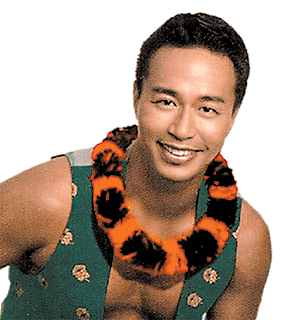


‘Kumu’ not a title
to be taken lightly
Tony Conjugacion's
By John Berger
halau debuts tomorrow
Special to the Star-BulletinWhen is a kumu hula not a kumu hula? It may sound like a trick question, but for people involved in hula it isn't a laughing matter. A kumu hula is someone who has been found qualified by another kumu to teach the techniques and traditions of the dance.
Growing numbers of people want the prestige that comes with the title, but there is no formal governing body that provides certification in the way that western cultures regulate medical doctors, dentists, attorneys, accountants and other professionals. Almost anyone can style themselves a "kumu hula," especially if they're outside Hawaii.
Tony Conjugacion found himself in the middle of the debate when he moved to New York in 1989.
"There were people who had 'halaus' who were teaching belly dancing! Some of those teachers in New York hate my guts, but don't exploit my culture! I taught (hula) when I was there because it kept me grounded, and I heard later that people who took a couple of workshops suddenly had their own halau.
"I put a stop to that whenever I can because they didn't train with me long enough to understand my style."
Conjugacion began studying hula at the age of 11 when he was still "Little Anthony," a protege of Melveen Leed. He has been teaching hula more than 10 years, but didn't open a halau until last year. It wasn't a decision made easily.
He taught a short series of classes at Palama Settlement last year, but when the program ended, he said, "The students said that I was their kumu. If I stopped teaching they would stop dancing. I asked kupuna for advice and they told me it was a decision I had to make.
"I talked it over with the students, and I decided after living in New York for four years that this is my home. This is my conduit of mana and aloha and energy and I'm going to be here."
His students, Halau Na Wainohia, make their formal public debut tomorrow evening at the Hawai'i Theatre. Joining them will be several guest artists, and the program will also showcase Conjugacion's talents as dancer, falsetto vocalist and veteran of the Broadway cast of "Miss Saigon."
But before Broadway called, Conjugacion had studied under several kumu, including Darrell Lupenui and Maiki Aiu Lake.
Another Lake alumnus was Robert Cazimero, who agreed with Conjugacion on the subject of "instant kumu syndrome." He said, "Lake used to say, 'Two times to the dentist doesn't make you the doctor.' " He graduated as kumu hula from Lake's Halau Hula O Maiki in 1973 and has been a prominent figure in hula ever since.
"I have people who used to dance for me who have not graduated but are teaching. They cannot claim the hula lineage I have."
Graduation, or uniki, takes place when the kumu hula feels the student is ready for the responsibilities of teaching. A student will uniki as a dancer (olapa) and then as a hoopaa (memorizer/chanter) before going through the uniki process. There is no time frame. A kumu may uniki dozens of kumu over the years. Another may wait until he or she is ready to retire or pass away before designating an heir. Or, a kumu may decide that the knowledge dies with them.
In some cases, Conjugacion says, someone who didn't go through the uniki process was "sanctioned" by a recognized kumu hula as qualified to teach as a kumu.
Conjugacion says that the best way to check a kumu's credentials is to ask for his or her hula genealogy. Who was their kumu? Who was their kumu's kumu hula?
"Ask what their hula lineage is, who their teachers were, what style and where the style originated from. If they cannot answer those questions, then they're not legitimate. If someone says they learned from this person or that person, check it out."
Tony Conjugacion and
Halau Na WainohiaSpecial guests: Brother Noland, Keao Costa, Palolo, Amy Hanaiali'i Gilliom & Willie K, Darren Hochstedler and Matthew Pedersen
In concert: 7:30 p.m. tomorrow
Place: Hawai'i Theatre
Admission: $21, $26
Call: 528-0506